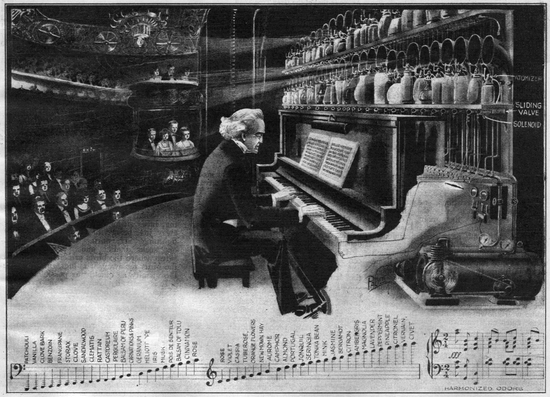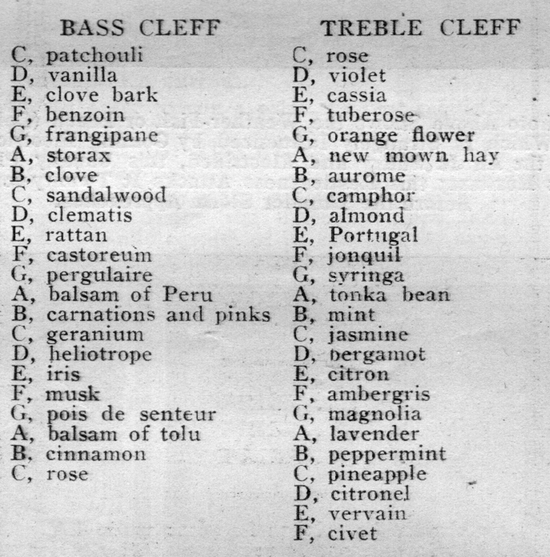The “smell organ” as illustrated by Frank R. Paul in the June 1922 issue of Science and Invention

The June 1922 issue of Science and Invention magazine featured a rather peculiar invention which envisioned an entirely new (and entirely silent) kind of concert. The invention was based on the theories of Dr. Septimus Piesse, a French chemist and perfumer who wrote the 1857 book The Art of Perfumery. Piesse often used music as a way to talk about how certain smells could work together. Just as certain notes could be played together in harmony, while others caused discord and were unpleasant to the ear, so too could certain smells be combined to create a beautiful bouquet while others smell terrible when combined.
Science and Invention took Piesse’s theories and ran with them, imagining a new kind of concert where musicians might “play” smells rather than sounds. We see, in an illustration by Frank R. Paul, a dapper gentleman sitting in front of a keyboard, sheet music at the ready and fragrances being coaxed from his fingers out of the bottles above and wafting over an attentive audience.
The article explains the vision for this “smell organ”:
Of course, the combination of these odors will create a smell entirely different from any of the individual qualities of the various perfumes and it is necessary that, in the soft, dreamy compositions, the odors blend harmoniously. Discords will have a decidedly unpleasant effect but inasmuch as the composers did not dwell upon discords to any great extent, the audience will be saved the rather unusual embarrassment of smelling disagreeable combination. Some music, would perhaps have to be changed and the odors carefully graduated so that in the smells wafted over the audience no particular perfume will predominate, except when the loud pedal, or rather, in these smell organs, the strong odor pedal is trod upon.
It is, therefore, up to the perfumer to combine the mixtures in much the same way as an artist blends colors, or as a good florist makes up his bouquet. If it is desirable to insert a little contrast into the bouquet, the appropriate blossoms or grasses are used, and so the perfumer, likewise would have to employ the proper aromas.
The article further explains that the “heavier” odors have been assigned the low notes on the organ while the “sharper” pungent odors are found where the high notes would be on a regular keyboard. Starting with the bass cleff three octaves below middle C, the article lays out which notes would correspond to which fragrances:
Key for which fragrances correspond to certain notes on the “smell organ” (1922)

There doesn’t appear to be any evidence that this particular smell organ was ever constructed, but 20th-century entertainers frequently experimented with smell-o-vision. Using smells to enhance 3D movies is par for the course at the Disney theme parks, with fragrances sprayed from the seats in front of each audience member so that not only do they see a stink bug on screen, they also smell it.





